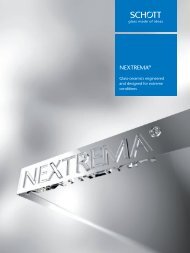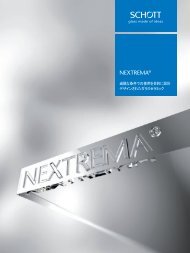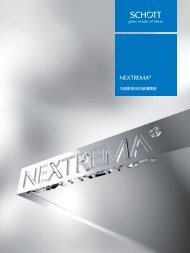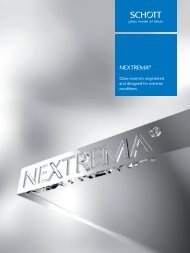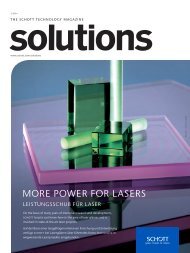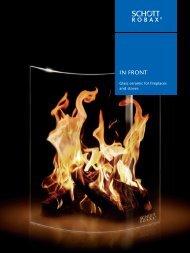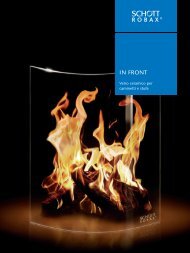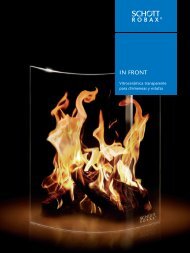SCHOTT Technical Glasses
Apart from its application in optics, glass as a technical material has exerted a formative influence on the development of important technological fields such as chemistry, pharmaceutics, automotive, optics, optoelectronics and information technology. SCHOTT Technical Glasses offers pertinent information in concise form. It contains general information for the determination and evaluation of important glass properties and also informs about specific chemical and physical characteristics and possible applications of the commercial technical glasses produced by SCHOTT. With this brochure, we hope to assist scientists, engineers, and designers in making the appropriate choice and make optimum use of SCHOTT products.
Apart from its application in optics, glass as a technical material has exerted a formative influence on the development of important technological fields such as chemistry, pharmaceutics, automotive, optics, optoelectronics and information technology. SCHOTT Technical Glasses offers pertinent information in concise form. It contains general information for the determination and evaluation of important glass properties and also informs about specific chemical and physical characteristics and possible applications of the commercial technical glasses produced by SCHOTT. With this brochure, we hope to assist scientists, engineers, and designers in making the appropriate choice and make optimum use of SCHOTT products.
Create successful ePaper yourself
Turn your PDF publications into a flip-book with our unique Google optimized e-Paper software.
56<br />
9.5 Passivation glasses<br />
Passivation glasses are zinc-borosilicate and lead-alumina<br />
silicate glasses used for chemical and mechanical protection<br />
of semiconductor surfaces.<br />
Processing<br />
To avoid distortion and crack formation, the different coefficients<br />
of thermal expansion of the passivation glass and<br />
the other semiconductor components must be taken into<br />
account. If the mismatch is too large, a network of cracks will<br />
originate in the glass layer during cooling or subsequent<br />
processing and destroy the hermetic protection of the semiconductor<br />
surfaces. Basically, there are three ways of overcoming<br />
this problem:<br />
The thinner the passivation glass layer, the smaller is the risk<br />
of cracking. <strong>SCHOTT</strong> therefore recommends maximum thicknesses<br />
for all homogeneous passivation layers that, as a rule,<br />
should not be exceeded.<br />
The sealing stress between glass and silicon, and thus<br />
the risk of cracking, can be reduced by slow cooling in the<br />
transformation range. As a rough rule, a cooling rate of<br />
5 K/min is suitable for passivation layers in the temperature<br />
range T g ± 50 K.<br />
Another way of avoiding thermal expansion mismatches is<br />
using composite glasses. Composites consist of a mixture of<br />
passivation glass powder and an inert filler such as, for example,<br />
powdered ceramics with very low or negative thermal<br />
expansion. Such fillers lower the mean thermal expansion<br />
coefficient of the passivation glass and thus minimize or<br />
eliminate the risk of cracking. As a secondary effect, fillers<br />
improve the mechanical stability of the composite glass.<br />
Different processing techniques, adjusted to the requirements<br />
of the respective applications, are employed. For the<br />
manufacturing of sintered glass diodes, usually a slurry of<br />
glass powder and deionized water is applied to the diode<br />
body, including the Mo- or W-contact studs. For wafer passivation<br />
(glass applied to the Si wafer before separating the<br />
chips), an organic suspension is applied by spinning, doctor<br />
blading, sedimentation, electrophoresis, or screen printing.<br />
The organic suspension vehicles must be completely volatile<br />
or thermally decomposable below the softening temperature<br />
of the glass.<br />
Properties<br />
Electrical insulation, including dielectric breakdown resistance,<br />
generally depends on the alkali content, particularly<br />
on the Na + content. Alkali contamination in <strong>SCHOTT</strong> passivation<br />
glasses is kept low by selecting pure raw materials<br />
and special manufacturing procedures. Contamination is<br />
tested for every batch. Typical contents are below 100 ppm<br />
for Na 2 O and K 2 O, and below 20 ppm for Li 2 O. Some composite<br />
passivation glasses may contain fillers with slightly<br />
higher amounts of alkali; because the mobility of alkali ions<br />
is negligible, there is no risk of impairing the quality of the<br />
component.<br />
Polished section of a glass-encapsulated silicon diode<br />
Diodes prepared for delivery (e.g. small signal diodes)






